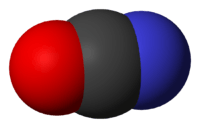Cyanate

The cyanate ion is an anion with the chemical formula written as [OCN]− or [NCO]−. In aqueous solution it acts as a base, forming isocyanic acid, HNCO. The cyanate ion is an ambidentate ligand, forming complexes with a metal ion in which either the nitrogen or oxygen atom may be the electron-pair donor. It can also act as a bridging ligand. Organic cyanates are called isocyanates when there is a C−NCO bond and cyanates when there is a C−OCN bond.
Cyanate ion
The three atoms in a cyanate ion lie on a straight line, giving the ion a linear structure. The electronic structure is described most simply as
- :Ö̤−C≡N:
with a single C−O bond and a triple C≡N bond. The infrared spectrum of a cyanate salt has a band at ca. 2096 cm−1; such a high frequency is characteristic of a triple bond.[1] The cyanate ion is a Lewis base. Both the oxygen and nitrogen atoms carry a lone pair of electrons and either one or the other, or both can be donated to Lewis acid acceptors. It can be described as an ambidentate ligand.
Acid-base properties
Isocyanic acid, HNCO, is produced when a cyanate salt is acidified. Although the electronic structure according to valence bond theory can be written as HN=C=O, as illustrated, the vibrational spectrum has a band at 2268.8 cm−1 in the gas phase, which clearly requires the C≡N bond to be a triple bond.[2][3] In valence bond theory the canonical form HN+≡C-O− is the major contributor to the resonance hybrid. The pure compound has a melting point of −86.8 °C and a boiling point of 23.5 °C, so it is volatile at ambient temperatures.[4][5] In aqueous solution it is a weak acid.
On heating isocyanic acid is converted to the trimer cyanuric acid, which itself decomposes on further heating back to isocyanic acid.[4] In the reverse of the famous synthesis of urea by Friedrich Wöhler,
- OC(NH2)2 → HNCO + NH3
isocyanic acid is produced and rapidly trimerizes to cyanuric acid.
The tautomer, known as cyanic acid, HOCN, in which the oxygen atom is protonated, is unstable to decomposition, but in solution it is present in equilibrium with isocyanic acid to the extent of about 3%. The vibrational spectrum is indicative of the presence of a triple bond between the nitrogen and carbon atoms.[7]
Cyanate salts
Sodium cyanate is isostructural with sodium fulminate, confirming the linear structure of the cyanate ion.[8] It is made industrially by heating a mixture of sodium carbonate and urea.[9]
- Na2CO3 + 2 OC(NH2)2 → 2 NaNCO + CO2 + 2 NH3 + H2O
A similar reaction is used to make potassium cyanate. Cyanates are produced when cyanides are oxidized. Use of this fact is made in cyanide decontamination processes where oxidants such as permanganate and hydrogen peroxide are used to convert toxic cyanide to safer cyanate.
Complexes with the cyanate ion
Cyanate is an ambidentate ligand which can donate the pair of electrons on the nitrogen atom or the oxygen atom, or both. Structurally the isomers can be distinguished by the geometry of the complex. In N-bonded cyanate complexes the M−NCO unit has a linear structure, but with O-bonded cyanate the M−O−C unit is bent. Thus, the silver cyanato complex, [Ag(NCO)2]−, has a linear structure, so is N-bonded.
Infrared spectroscopy has been used extensively to distinguish between isomers. Many complexes of divalent metals are N-bonded. O-bonding has been suggested for complexes of the type [M(OCN)6]n−, M = Mo(III), Re(IV) and Re(V). The yellow complex Rh(PPh3)3(NCO) and orange complex Rh(PPh3)3(OCN) are linkage isomers and show differences in their infrared spectra which can be used for diagnosis (PPh3 stands for triphenylphosphine).[10]
The cyanate ion can bridge between two metal atoms by using both donor atoms. For example, this structure is found in the compound [Ni2(NCO)2(en)2][BPh4]2. In this compound both the Ni−N−C unit and Ni−O−C unit are bent, even though in the first case donation is through the nitrogen atom.[11]
Cyanate in organic compounds
Organic compounds that contain the functional group −N=C=O are known as isocyanates. It is conventional in organic chemistry to write isocyanates with two double bonds, which accords with a simplistic valence bond theory of the bonding. In nucleophilic substitution reactions cyanate usually forms an isocyanate. Isocyanates are widely used in the manufacture of polyurethane[12] products and pesticides; Methyl isocyanate, used to make pesticides, was a major factor in the Bhopal disaster.
Compounds that contain the group −O−C≡N, are known as a cyanates, or cyanate esters. Aryl cyanates such are phenyl cyanate, C6H5OCN, can be formed by a reaction of phenol with cyanogen chloride, ClCN, in the presence of a base.
References
- ↑ Nakamoto, Part A, p171
- ↑ Nakamoto, part A, p 190
- ↑ "The CHNO Isomers". Chemische Berichte. 122: 753–766. doi:10.1002/cber.19891220425.
- 1 2 Greenwood, p323
- ↑ Wells, p 722
- ↑ IUPAC SC-Database A comprehensive database of published data on equilibrium constants of metal complexes and ligands
- ↑ Teles, Joaquim Henrique; Maier, Günther; Andes Hess, B.; Schaad, Lawrence J.; Winnewisser, Manfred; Winnewisser, Brenda P. (1989). "The CHNO Isomers". Chem. Ber. 122 (4): 1099–0682. doi:10.1002/cber.19891220425.
- ↑ Wells, p722.
- ↑ Greenwood, p324
- ↑ Nakamoto, Part B, pp 121–123.
- ↑ Greenwood, Table 8.9
- ↑ Seymour, Raymond B.; Kauffman, George B. (1992). "Polyurethanes: A Class of Modern Versatile Materials". J. Chem. Ed. 69: 909. doi:10.1021/ed069p909.
External links
Bibliography
- Greenwood, Norman N.; Earnshaw, Alan (1997). Chemistry of the Elements (2nd ed.). Butterworth-Heinemann. ISBN 0-08-037941-9.
- Nakamoto, K. (1997). Infrared and Raman spectra of Inorganic and Coordination compounds. Part A (5th ed.). Wiley. ISBN 0-471-16394-5.
- Nakamoto, K. (1997). Infrared and Raman spectra of Inorganic and Coordination compounds. Part B (5th ed.). Wiley. ISBN 0-471-16392-9.
- Wells, A.F (1962). Structural Inorganic Chemistry (3rd. ed.). Oxford: Clarendon Press. ISBN 0-19-855125-8.